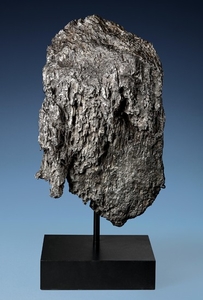A MASSIVE DRONINO METEORITE — EXTRATERRESTRIAL TABLETOP SCULPTURE, Iron, ataxite (ungrouped) Ryazan district, Russia (54° 44' N, 41° 25' E)
The highly crenelated signature surface texture of Dronino is seen in the midsection of this mass. The extremities of this meteorite are strangely smoother. Apart from this uniquely-shaped specimen, meteorites do not look like this. With a platinum-hued patina, this is a decorative example of a singularly exotic meteorite. Accompanied by a custom armature.
429 x 251 x 176 mm. (16¾ x 9¾ x 7 in.) and 40.45 kg. (89 lbs)
There is no other meteorite that looks like Dronino and the specimen now offered is remarkable. Evocative of a surreal Tiffany Wisteria lampshade, this is an unusually large example of an scientifically noteworthy meteorite. The first Dronino meteorite was discovered by a mushroom hunter in Russia in 2000. While the vast majority of iron meteorites are members of established chemical groups, 11% have no chemical relation to anything previously known and Dronino is one of these exotic, ungrouped irons. The implication of Dronino’s unique chemical signature is that it originated from a previously unknown parent asteroid. Dronino meteorites were recovered approximately 20 kilometers from an ancient town founded in 1152. As nothing was ever written about what would have been an extremely memorable event of a fireball accompanied by sonic booms and a smoke trail, it can be inferred that Dronino‘s arrival occurred when the area was unpopulated. Given the extent of terrestrial sculpting, a descent to Earth more than a millennium ago can be confidently fixed. With a shape and chemistry that’s unique, this singularly unusual meteorite is the furthest thing from a textbook example.
Christie's would like to thank Dr. Alan E. Rubin at the Institute of Geophysics and Planetary Physics, University of California, Los Angeles for his assistance in preparing this catalog note.
View it on
Sale price
Estimate
Time, Location
Auction House
The highly crenelated signature surface texture of Dronino is seen in the midsection of this mass. The extremities of this meteorite are strangely smoother. Apart from this uniquely-shaped specimen, meteorites do not look like this. With a platinum-hued patina, this is a decorative example of a singularly exotic meteorite. Accompanied by a custom armature.
429 x 251 x 176 mm. (16¾ x 9¾ x 7 in.) and 40.45 kg. (89 lbs)
There is no other meteorite that looks like Dronino and the specimen now offered is remarkable. Evocative of a surreal Tiffany Wisteria lampshade, this is an unusually large example of an scientifically noteworthy meteorite. The first Dronino meteorite was discovered by a mushroom hunter in Russia in 2000. While the vast majority of iron meteorites are members of established chemical groups, 11% have no chemical relation to anything previously known and Dronino is one of these exotic, ungrouped irons. The implication of Dronino’s unique chemical signature is that it originated from a previously unknown parent asteroid. Dronino meteorites were recovered approximately 20 kilometers from an ancient town founded in 1152. As nothing was ever written about what would have been an extremely memorable event of a fireball accompanied by sonic booms and a smoke trail, it can be inferred that Dronino‘s arrival occurred when the area was unpopulated. Given the extent of terrestrial sculpting, a descent to Earth more than a millennium ago can be confidently fixed. With a shape and chemistry that’s unique, this singularly unusual meteorite is the furthest thing from a textbook example.
Christie's would like to thank Dr. Alan E. Rubin at the Institute of Geophysics and Planetary Physics, University of California, Los Angeles for his assistance in preparing this catalog note.



